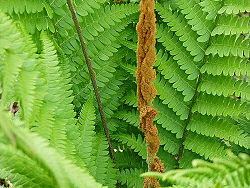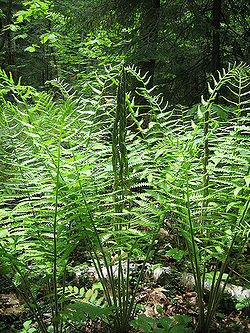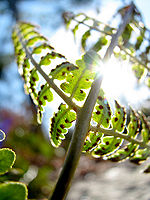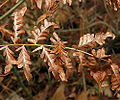Cinnamon fern
| Cinnamon fern |
|---|

|
| Scientific Classification |
|
| Binomial Name |
|
Osmunda cinnamomea |
| This is a colony of a Cinnamon fern |
This Cinnamon fern is a large and very common fern with fronds growing up to six feet long and a foot wide. They not actually produce the cinnamon spice or smell like cinnamon, rather it was named that because of its color. The croziers (fiddleheads) are used for food by many animals and has been used for medicine by Native Americans.
Anatomy
It's a deciduous herbaceous plant. The sterile fronds spread, 30-150 cm tall and 15-20 cm broad, the pinnae is 5-10 cm long and 2-2.5 cm broad. The fertile fronds are shorter, 20-45 cm tall; they are cinnamon-colored after they begin to grow, which gives it its name. The fertile leaves come first; they are green for a while but it will slowly become brown as the season goes on and the spores drop. The spore-bearing stems keep going after the fronds that are sterile get killed by the frost and snow, until the next season. The spores have to develop within a few weeks or else they will die.
rhizoids - primitive filaments that serve the prothallus as "roots"
antheridia - the fern's male sex organs, which produce sperm
archegonia - the fern's female sex organs, which produce eggs
[1]
Reproduction
A Cinnamon Fern has two types of fronds: the big green ones, and smaller ones which start out bright green and then turn a cinnamon color. The cinnamon-colored ones have sori on them. Sori make spores, which are like seeds for other plants. Fern spores are how the fern can make new ferns. Once several large fronds have grown, then the smaller ones with sori will grow. Then fern will stop growing new fronds in a couple of months. It will instead grow spores to be spread to new places to grow new ferns.[2]
1. A sporophyte phase produces haploid spores by meiosis.
2. A spore grows by mitosis into a gametophyte.
3. The gametophyte produces gametes by mitosis.
4. A flagellate sperm fertilizes an egg that is still attached to the prothallus.
5. The fertilized egg has become a diploid zygote and grows by mitosis into a sporophyte.
[3]
Ecology
This Cinnamon fern forms big colonies in swamp areas. They are normally found in shady places. They are not picky plants, which means if it is in a shady mid-temperature area, you will probably find one. There are many found in back yards or green belts. They are found near water or damp/moist areas and like cooler shady areas. You can also purchase Cinnamon ferns from larger plants nurseries and maybe obtain some seeds from smaller places.
Other
Video on Fiddle heads.
Gallery
 Browse |
References
- Osmunda cinnamomea (cinnamon fern) by the U.S. Department of Agriculture
- Cinnamon Fern James Manhart.
- Osmunda cinnamomea Natural Resources Conservative Service.
- Osmunda cinnamomea Earl J.S. Rook. February 26, 2004
See Also







